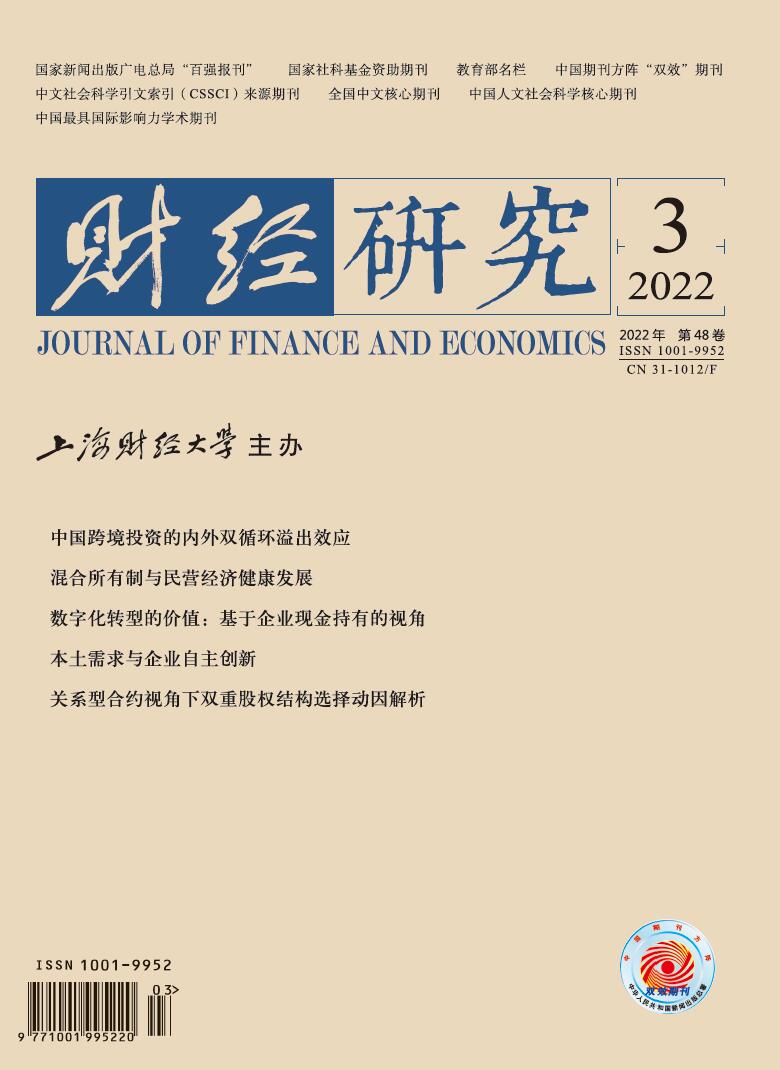在面临如亚洲金融风暴、全球金融危机和新冠肺炎疫情等巨大负向外部冲击时,我国逆周期的财政政策能产生明显的效果。为厘清经济周期和财政政策的关系,文章首先运用汉密尔顿滤波方法估计我国的产出缺口和财政周期,然后运用时变参数向量自回归模型从宏观层面测度我国经济周期和财政政策周期之间的时变交互影响,最后运用非线性的面板工具变量局部投影模型从省级维度测度经济周期和财政周期视角下的财政支出乘数。研究结果表明:第一,从宏观层面看,亚洲金融风暴、全球金融危机和新冠肺炎疫情爆发等事件对我国经济周期的负面冲击促使财政政策逆周期扩张,而财政周期扩张对经济周期复苏具有显著的推动作用;第二,从省级层面看,地方财政支出乘数在经济紧缩时期更高,这个规律对东、中、西部三大经济区域同样适用;第三,无论是从宏观层面还是省级层面,顺周期财政政策都有较高的时间占比,而顺周期的财政政策是引致中国经济周期波动的重要政策因素;第四,我国地方政府实施的财政政策可能没有对居民消费产生显著的促进作用,而投资乘数却保持较高水平,这表明我国财政政策对经济增长的乘数效应主要通过投资渠道实现。文章结论对理解我国经济周期和财政政策周期之间的关联机制具有重要启示意义,同时也指出财政政策逆周期调控的必要性以及未来优化财政支出结构从而更好地引领居民消费的迫切性。
经济周期和财政政策周期交互视角下的乘数效应研究——基于全国层面和省级层面的分析
摘要
参考文献
2 丛树海,张源欣. 财政政策的顺周期实施效应特征与基本成因[J]. 财贸经济,2018,(6):30−42. DOI:10.3969/j.issn.1002-8102.2018.06.004
4 付一婷,陈润东,刘金全. 经济周期和空间分异视角下的财政资源再配置−基于全国和省级财政乘数的分析[J]. 财贸经济,2021,(9):97−111. DOI:10.3969/j.issn.1002-8102.2021.09.007
11 石绍宾,尹振东,汤玉刚. 财政分权、融资约束与税收政策周期性[J]. 经济研究,2019,(9):90−105. DOI:10.3969/j.issn.1672-5719.2019.09.080
12 司海平,刘小鸽,魏建. 地方政府债务融资的顺周期性及其理论解释[J]. 财贸经济,2018,(8):21−34. DOI:10.3969/j.issn.1002-8102.2018.08.002
13 孙天琦,杨岚,苗文龙. 中国财政政策是否具有顺周期性[J]. 当代经济科学,2010,(3):1−10. DOI:10.3969/j.issn.1002-2848.2010.03.001
19 Alesina A, Campante F R, Tabellini G. Why is fiscal policy often procyclical?[J]. Journal of the European Economic Association,2008,6(5): 1006−1036. DOI:10.1162/JEEA.2008.6.5.1006
21 Avellan L, Vuletin G. Fiscal procyclicality and output forecast errors[J]. Journal of International Money and Finance,2015,55: 193−204. DOI:10.1016/j.jimonfin.2015.02.008
22 Bernardini M, De Schryder S, Peersman G. Heterogeneous government spending multipliers in the era surrounding the Great Recession[J]. The Review of Economics and Statistics,2020,102(2): 304−322. DOI:10.1162/rest_a_00830
23 Blanchard O, Perotti R. An empirical characterization of the dynamic effects of changes in government spending and taxes on output[J]. the Quarterly Journal of economics,2002,117(4): 1329−1368. DOI:10.1162/003355302320935043
24 Caballero R J, Krishnamurthy A. Fiscal Policy and Financial Depth[R]. NBER Working Paper No.10532, 2004.
25 Driscoll J C, Kraay A C. Consistent covariance matrix estimation with spatially dependent panel data[J]. The Review of economics and statistics,1998,80(4): 549−560. DOI:10.1162/003465398557825
26 Frankel J A, Vegh C A, Vuletin G. On graduation from fiscal procyclicality[J]. Journal of Development Economics,2013,100(1): 32−47. DOI:10.1016/j.jdeveco.2012.07.001
27 Gavin M, Perotti R. Fiscal policy in latin america[J]. NBER Macroeconomics Annual,1997,12: 11−61. DOI:10.1086/654320
28 Hamilton J D. Why you should never use the Hodrick-Prescott filter[J]. The Review of Economics and Statistics,2018,100(5): 831−843. DOI:10.1162/rest_a_00706
32 Ramey V A, Zubairy S. Government spending multipliers in good times and in bad: Evidence from US historical data[J]. Journal of Political Economy,2018,126(2): 850−901. DOI:10.1086/696277
33 Talvi E, Végh C A. Tax base variability and procyclical fiscal policy in developing countries[J]. Journal of Development economics,2005,78(1): 156−190. DOI:10.1016/j.jdeveco.2004.07.002
34 Tornell A, Velasco A. The tragedy of the commons and economic growth: why does capital flow from poor to rich countries?[J]. Journal of Political Economy,1992,100(6): 1208−1231. DOI:10.1086/261858
引用本文
刘金全, 陈润东. 经济周期和财政政策周期交互视角下的乘数效应研究——基于全国层面和省级层面的分析[J]. 财经研究, 2022, 48(3): 109-123.
导出参考文献,格式为:
上一篇:教师支持行为与儿童非认知能力发展
下一篇:中国长期护理保险不同筹资模式研究





 5442
5442  8485
8485

